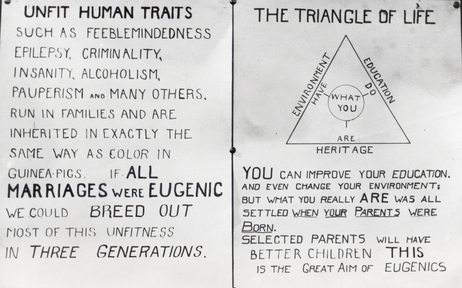The shadow selves of American history often don't leave much of a photographic record, but sometimes there are just a few shards of proof and reminders of what has happened.
Eugenics, a dark offshoot of the science of genetics, was an early 20th century movement that sought to prevent social ills by seeing that those who caused them were never born. The movement produced an awful lot of books, tracts and pamphlets, but it didn't leave behind much in the way of photographs.
What is certainly the most intriguing — and probably the most numerous — collection of eugenics-related photographs can be found in a scrapbook assembled by the members of the American Eugenics Society, now in the holdings of the American Philosophical Society in Philadelphia.
I learned of the scrapbook while doing the image research for a PBS documentary on the history of deaf culture in America, and it has always stuck in my mind as particularly disturbing and particularly American. Deaf people were a target for eugenicists from the beginning, with, most notably, Alexander Graham Bell advocating that deaf people should not marry.

The movement considered many other attributes to be hereditary — from feeblemindedness, pauperism and criminality to promiscuity among women and even love of the sea. Love of the sea was pretty much a curiosity, but people with the rest of those "undesired" traits were in the sights of the movement as it sought to prevent them from marrying or having children, often through forced or coerced sterilization.
The scrapbook at the American Philosophical Society features eugenics activities at several state fairs: public presentations, examination buildings and "fitter family contests."
In a way, this makes perfect sense. Born out of a society that was still making the transition from agricultural to industrial, much of the eugenics argument was based on the idea that we selectively breed our livestock for desired traits; why not do the same with human society?
As one sign asks, "Are you a thoroughbred?"
On the other hand, this system of beliefs reached full flower in the extermination camps of Nazi Germany, and seeing its earlier stages in the wholesome setting of Midwestern state fairs, with folding chairs under the shade trees and the science-fair quality of the displays, is creepy in a way that few things are.
Looking at the winners of the various fitter family contests, now that a few generations have passed, I can't help but wonder how these families from small towns in Kansas, Michigan and Georgia have played out.
Found in the Archives, a Picture Show miniseries running at the beginning of each month, features archival films and found images selected by researcher Rich Remsberg. (Visit link at top for more archive old pictures, worth the visit)
Eugenics, a dark offshoot of the science of genetics, was an early 20th century movement that sought to prevent social ills by seeing that those who caused them were never born. The movement produced an awful lot of books, tracts and pamphlets, but it didn't leave behind much in the way of photographs.
What is certainly the most intriguing — and probably the most numerous — collection of eugenics-related photographs can be found in a scrapbook assembled by the members of the American Eugenics Society, now in the holdings of the American Philosophical Society in Philadelphia.
I learned of the scrapbook while doing the image research for a PBS documentary on the history of deaf culture in America, and it has always stuck in my mind as particularly disturbing and particularly American. Deaf people were a target for eugenicists from the beginning, with, most notably, Alexander Graham Bell advocating that deaf people should not marry.

American Philosophical Society
The American Eugenics Society promoted ideas of racial betterment and genetic education through public lectures, conferences, publications and exhibits at county and state fairs — like this chart labeled "The Triangle of Life" from the Kansas Free Fair.
The American Eugenics Society promoted ideas of racial betterment and genetic education through public lectures, conferences, publications and exhibits at county and state fairs — like this chart labeled "The Triangle of Life" from the Kansas Free Fair.
The scrapbook at the American Philosophical Society features eugenics activities at several state fairs: public presentations, examination buildings and "fitter family contests."
In a way, this makes perfect sense. Born out of a society that was still making the transition from agricultural to industrial, much of the eugenics argument was based on the idea that we selectively breed our livestock for desired traits; why not do the same with human society?
As one sign asks, "Are you a thoroughbred?"
On the other hand, this system of beliefs reached full flower in the extermination camps of Nazi Germany, and seeing its earlier stages in the wholesome setting of Midwestern state fairs, with folding chairs under the shade trees and the science-fair quality of the displays, is creepy in a way that few things are.
Looking at the winners of the various fitter family contests, now that a few generations have passed, I can't help but wonder how these families from small towns in Kansas, Michigan and Georgia have played out.
Found in the Archives, a Picture Show miniseries running at the beginning of each month, features archival films and found images selected by researcher Rich Remsberg. (Visit link at top for more archive old pictures, worth the visit)
The article is reproduced in accordance with Section 107 of title 17 of the Copyright Law of the United States relating to fair-use and is for the purposes of criticism, comment, news reporting, teaching, scholarship, and research.

No comments:
Post a Comment